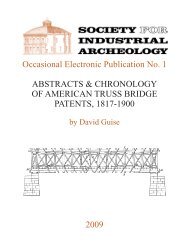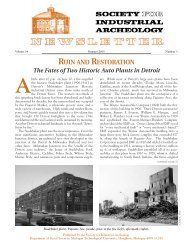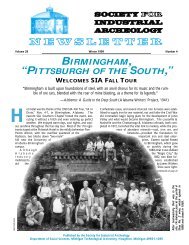RUHR, GERMANY - Society for Industrial Archeology
RUHR, GERMANY - Society for Industrial Archeology
RUHR, GERMANY - Society for Industrial Archeology
Create successful ePaper yourself
Turn your PDF publications into a flip-book with our unique Google optimized e-Paper software.
<strong>RUHR</strong>, <strong>GERMANY</strong> TICCIH<br />
(continued from page 7) (continued from page 16)<br />
kind. We continued strolling about the museum after lunch and<br />
took turns operating the handcar.<br />
Our tour ended at the Aquarius Wassermuseum in Mulheim.<br />
Owned by the private waterworks, Rheinisch-We s t f ä l i s c h e<br />
Wasserwerksgesellschaft, the tower was built by August Thyssen<br />
in 1892-93 to supply water to his nearby ironworks. It also supplied<br />
drinking water to residents until 1982. Now it is a museum<br />
of water in a broad sense. Multimedia exhibits cover water-related<br />
disaster, cultural differences in bathing, sewerage systems,<br />
canals, purification and, of course, those great consumers of water,<br />
coal mining and steelmaking. The local press came by to document<br />
our visit. The museum hosted our farewell reception, where<br />
a sumptuous buffet was accompanied by a jazz trio. Some SIA<br />
members took to the dance floor.<br />
Wolfgang rose to tell us he’d been asked to make a tearful<br />
speech, but didn’t understand the idiom. As newfound friends, he<br />
asked us to remember the keyword, relevance, as we pursue our<br />
love of industrial heritage. No period has changed history as<br />
much as the past 200 years, but industrialization is over. Urban<br />
development must take reuse into account so that we save something.<br />
Regeneration of industrial areas can be achieved through<br />
“valuing” industrial heritage. If the Ruhr Tour had an important<br />
lesson <strong>for</strong> SIA members, it showed us what can be accomplished<br />
to change people’s attitudes about industrial sites when they are<br />
integrated with real community needs, such as spaces <strong>for</strong> cultural<br />
activities, gardens, and community centers. Following a <strong>for</strong>mal<br />
thank you from SIA President, Carol Poh Miller, Pat Martin presented<br />
Wolfgang with a gift of a triptych of industrial photos<br />
taken by Gerald Weinstein [SIA], who graciously donated them.<br />
As we departed <strong>for</strong> the hotel, we heard Wolfgang, <strong>for</strong> the last<br />
time, call out, “Are we complete?” And Pat’s answer, “We are<br />
complete!” Instead of our usual, “Gute nacht,” Wolfgang asked us<br />
to remember, “No surrender until it is preserved!” and wished us<br />
good-bye with, “Auf wiedersehen,” (until we see each other<br />
again). I think we all hope that we will.<br />
L’ENFANT’S PATERSON<br />
(continued from page 7)<br />
sure of success was the designation of the Great Falls National<br />
Historic Landmark District, but the tourists that preservationists<br />
once imagined would delight in learning about the city’s industrial<br />
achievements have not appeared, nor have they been aggressively<br />
pursued by advertising or first-class interpretive exhibits.<br />
Lost to the historical accounts of the district’s textiles, revolvers,<br />
and locomotives, however, is the fact that the acreage just below<br />
the falls that includes the ATP Site is the hub of a spoked-wheel<br />
city plan of streets that radiate throughout the city. Like its better<br />
known Washington counterpart, the Paterson city plan began<br />
as a work of classical proportions designed by a genius.<br />
The Alexander Hamilton National Memorial is a recently<br />
established nonprofit organization dedicated to preserving and<br />
commemorating the Founding Father’s accomplishments in<br />
Paterson. Info: Box 20631, Cherokee Station, New York, NY<br />
10021-0072; n i c k s u n d a y @ h a m i l t o n m e m o r i a l . c o m . The Alexander<br />
Hamilton National Memorial Website: w w w. h a m i l t o n m e m o r i a l . o r g .<br />
Nick Sunday<br />
<strong>Society</strong> <strong>for</strong> <strong>Industrial</strong> <strong>Archeology</strong> Newsletter, Vol. 30, No. 2, 2001<br />
first synthetic dye (1856); a model of the Firth of Forth Bridge;<br />
the Model T Ford (1916); the atomic particle accelerator<br />
designed by Cockroft and Walton (1937); and the Apollo 10<br />
rocket (1969).<br />
Of the three optional post-conference tours, I chose Wales<br />
because of its long tradition of mining. Among the sites we visited<br />
was Cyfartha Iron Furnaces in Merthy, established 1786-1810<br />
by Richard Crawshay, who is credited with introducing the puddling<br />
process <strong>for</strong> refining pig iron into wrought iron. Except <strong>for</strong><br />
five preserved blast furnaces, the works were demolished in 1960.<br />
A highlight of the Wales tour was the Blaenavon <strong>Industrial</strong><br />
Landscape, a UNESCO World Heritage site. The landscape,<br />
which ranges over 33 sq. kms., interprets how coal mining, processing,<br />
and transporting changed the landscape from the 1780s<br />
to 1970s. Components include the Blaenavon Ironworks, the<br />
Brecknock and Abergavenny Canal, and the town of Blaenavon.<br />
Interpretation and conservation projects to date have concentrated<br />
at the Big Pit mine, in operation 1830-1980. We toured the<br />
engine house, compressor house, fan house, sawmills, machine<br />
shops, foundry, electric power plant, and facilities <strong>for</strong> the managers<br />
and workers, such as the canteen, clinic, and offices. Led by<br />
retired miners, a visit in the underground mine included displays<br />
of tools, wagons, and even the stalls <strong>for</strong> horses that worked in the<br />
mine until the early 1960s. A final stop of the Wales tour was the<br />
Museum of the Great Western Railway in Swindon, located in<br />
a section of the restored workshops established by I. K. Brunel in<br />
1840. Exhibits there focus on the social context of the works<br />
including labor relations, foundry trades, gender roles in the workshops,<br />
working conditions, and education.<br />
I observed that our European colleagues in TICCIH remain<br />
concentrated on the study of the classic pre-1900 IA sites of the<br />
<strong>Industrial</strong> Revolution. On a whole, TICCIH does not focus on<br />
the industrial processes of the 20th century. By comparison, SIA<br />
conferences more often explore the context of factory processes of<br />
the more recent past, a reflection of North America’s rapid industrial<br />
expansion beginning in the late 19th century. There is much<br />
room <strong>for</strong> cross-fertilization since so many technologies transferred<br />
in either direction across the Atlantic. Both organizations, SIA<br />
and TICCIH, have common ground, although they may sometimes<br />
differ in methodologies and research orientations. Many<br />
TICCIH colleagues expressed interest in identifying areas where<br />
the two groups could work in closer cooperation, especially with<br />
issues of advocacy, publications, and promotion of activities and<br />
membership.<br />
The XIIth TICCIH Conference will take place in Moscow and<br />
in Nizhny Tagil, July 10-18, 2003. The general theme will be<br />
“Preservation of <strong>Industrial</strong> Heritage and Rehabilitation of Old<br />
<strong>Industrial</strong> Centres."<br />
Louise Trottier<br />
19






